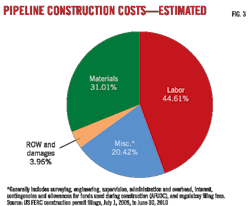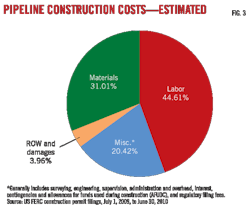SPECIAL REPORT: New synthetic-based muds allow more complex wells
Guntis Moritis
Production Editor
Improvements in drilling muds allow the oil and gas industry to complete more complicated wells in a more environmentally friendly manner.
These muds remain stable at higher temperatures and pressures as well as have properties that reduce the chance of stuck pipe when drilling through depleted zones that create a large pressure differential between the formation and the fluid in the drill pipe.
The industry continues to develop water-based muds (WBMs) with a greater performance range but for harsher drilling environments; the industry still mainly depends on synthetic-based muds (SBMs). Fig. 1 compares some performance characteristics of various muds.
Shell Chemical LP manufactures an olefin-based fluid for synthetic muds that has seen wide use in drilling deepwater Gulf of Mexico wells. Shell notes that some key advantages of SBMs over WBMs are higher penetration rates, thermal stability, lower reservoir damage, higher lubricity, low corrosion. longer bit life, and lower fluid loss. The table lists additional advantages and disadvantages of oil-based mud (OBM) over WBM.
Shell estimates that in 2009, drilling in the Gulf of Mexico consumed about 250 million lb of olefins.
Synthetic muds
The industry developed synthetic-based muds in the 1990s because experience in the North Sea revealed that drill cuttings coated with diesel used in oil-based mud was toxic and persisted in marine sediments near platforms. Low-aromatic mineral oil replaced diesel and then in many cases it was replaced by synthetic-based fluids that are more benign for the environment.
The base fluids for these SBMs include normal (linear) paraffins (LPs), linear alpha olefins (LAOs), poly alpha olefins (PAOs), and internal olefins (IOs). LAOs and IOs are the most common synthetic-base fluid used in the Gulf of Mexico.
Because of their high cost, companies usually recycle SBMs rather than dispose of them in the environment or by reinjection.
A small amount of SBM does reach the ocean floor with drill cuttings, if the area permits cuttings discharge such as in the Western Gulf of Mexico in which the new general National Pollutant Discharge Systems (NPDES) permit, introduced in February 2002, allows the retention of synthetic-base chemical on cuttings below 6.9% (for internal olefins) or 9.4% (for esters).
Shell's experience
Eric van Oort, performance improvement manager, wells, with Shell Exploration & Production, provided some insights on the performance of Neoflo fluids in Shell drilling operations.
Neoflo is a set of internal-olefin fluids that Shell Chemical produces for use in synthetic-based drilling mud. Various mud companies include Shell's base fluid in formulating SBMs. The formulated muds usually have a 70/30 or 80/20 olefin-to-water ratio.
Shell's Vladimir Martin, commercial manager for Neoflo, said his company is the largest producer of alpha and linear olefins for drilling muds, with a production facility based in Geismar, La.
According to van Oort, SBMs are the workhorse of deepwater drilling in the Gulf of Mexico because the reactive clays in the gulf do not react well with water-based mud. The muds with olefin systems provide both borehole stability as well as lubricity for directional wells and reduce the possibility of sticking the drillstring when drilling through depleted zones. He noted "some of the wells we drill, especially the more challenging extended reach wells, could not be drilled without them."
As the environmental restrictions for SBMs have increased in the gulf, the industry has worked with the US Environmental Protection Agency to define the criteria for the toxicity, biodegradeabiltiy, and retention of SBMs on cuttings.
Van Oort noted that Shell was the first in the gulf to put cuttings driers on the rigs to reduce the amount of mud retained by cuttings. The driers remove most of the SBM from the discharged cuttings that sink to the seabed where the remaining SBM biodegrades.
In a typical deepwater gulf well, companies use SBMs mostly for drilling the intermediate and production section of the well.
Van Oort said that if there is a depleted zone in the well, a 2,000 psi overbalance with WBM would likely lead to differential sticking, but because SBMs have an internal filter cake that provides superior fluid-loss properties, these muds allow for drilling wells with a large overbalance. WBMs have an external filter cake that can trap the drill pipe and cause it to stick at large overburdens.
In wells drilled on land such as in Texas, Shell has drilled wells with invert mud systems (which include SBMs and OBMs) that had as much as 9,000 psi overbalance, clearly demonstrating the superior stuck pipe protection offered by these systems, van Oort said.
In deep water, van Oort said Shell has used SBMs to provide the needed lubricity and hole cleaning capacity to overcome the friction in extended reach wells with extreme doglegs such as the Perdido wells in the gulf that are in 8,000-ft or greater water depths. Off Brazil in Blocks BC10 and BC-4, van Oort said Shell drills all deepwater wells with SBMs that essentially are the same as used in the Gulf of Mexico.
Other areas in which Shell uses SBMs are in drilling the tight gas sands in Wyoming's Pinedale field as well as in Canada, van Oort said. For areas such as off Alaska, companies do not require SBMs because the wells are not complex, although the logistics are.
Also he said that drilling nonreactive, stable, and hard shales in an area such as the Haynesville of Louisiana, companies have had no problem with WBMs.
The olefin muds have been used from freezing temperatures to wells that have 350° F. temperature and are 30,000-35,000 ft deep. Van Oort noted that muds have been formulated for 400° F. but have not yet been used.
He said one advantage of these muds is the flat rheology across a wide temperature and pressure range. Also for effective drilling one needs a low-kinematic viscosity in the base fluid (Fig. 2). Neoflo, for instance, provides rheological stable and thin drilling fluids that reduce equivalent circulating densities (ECDs) and have a low viscosity at low temperature that minimizes oil retention on drilling cuttings.
He explained that diesel and other mineral oil-based muds have a high kinematic viscosity that yields high ECDs that could result in drilling problems such as induced fracturing and lost circulation. Drilling in the gulf needs low ECDs because of the narrow pressure range between the pore pressure and the fracture gradient.
Although SMBs are widely used in the gulf, in places such as the North Sea that have minimal or zero discharge regulations, companies still use mineral oil-based mud for drilling because of the lower costs.
Van Oort noted that zero discharge in the gulf was looked at but rejected because of greater cuttings transport distances than in the North Sea that would cause more detrimental effects to the environment than the discharge of the cuttings to the seabed that have SBM that readily biodegrades.
The current benchmark standard in the gulf requires olefin muds to perform the same or better than the C16-C18 olefins produced by Chevron Phillips Chemical Co. LP.
Philip Dorn, global discipline leader and manager of exotoxicology for Shell Health-Americas, explained that Shell's internal olefin is better in sediment toxicity than the standard, has a low polyaromatic carbon content of less than 10 ppm, and has anaerobic biodegradability. This performance thus meets EPA's regulations for the gulf.
Dorn noted that oxygen levels in the deepwater gulf are low so that to have a minimum footprint the materials discharged to the seabed need to be anaerobically biodegradable and increase the probability that if there are discharged cuttings piles they will degrade in the absence of oxygen or very low oxygen.
In the design of Shell's olefin-based fluid, the company considers both the effects of the fluid on drilling as well as on the environment, Dorn said.
Carbon-bond positions and branching effect on fluid biodegradability are two features that differentiate olefins. He noted that longer carbon chains lower sediment toxicity while extensive branching will reduce anaerobic toxicity. Also alpha olefins may be somewhat more toxic in sediment tests than internal olefins, he noted.
Currently, Dorn said that there are no expected new proposed regulations for drilling muds in the gulf since the last changes made in 2007 and 2001.
More Oil & Gas Journal Current Issue Articles
More Oil & Gas Journal Archives Issue Articles
View Oil and Gas Articles on PennEnergy.com



